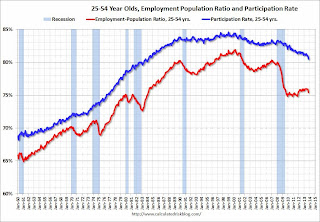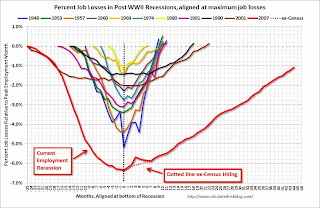by Calculated Risk on 11/08/2013 11:26:00 AM
Friday, November 08, 2013
Employment Report: Solid Report ex-Government Shutdown, Seasonal Retail Hiring highest since 1999
A few key points:
• The government shutdown impacted the unemployment rate and the participation rate. This impact from the shutdown should be reversed in the November report.
• Overall this was a solid employment report (except the impact of the government shutdown).
• Last weekend I noted four items that the Fed would probably be looking at to taper in December. Here were the two related to employment:
1) "If the unemployment rate declines back to 7.2% or so in November (the September rate), then the FOMC might taper." Since the unemployment rate only increased to 7.3% in October, it appears likely this will be met (the Fed will probably be looking for a bounce back in the participation rate in November too).
2) "If the year-over-year change in employment is still around 2.2 million for November, the FOMC might taper." Employment was up 2.329 million year-over-year in October. It appears very likely this level will be met in the November report.
• Seasonal retail hiring was solid. See the first graph below - this is a good sign for the holiday season ("Watch what they do, not what they say")
• And yes - several people have emailed me - I was thinking there would be an upside surprise for payrolls.
Seasonal Retail Hiring
According to the BLS employment report, retailers hired seasonal workers in October at the highest level since 1999.
 Click on graph for larger image.
Click on graph for larger image.
Typically retail companies start hiring for the holiday season in October, and really increase hiring in November. Here is a graph that shows the historical net retail jobs added for October, November and December by year.
This graph really shows the collapse in retail hiring in 2008. Since then seasonal hiring has increased back close to more normal levels. Note: I expect the long term trend will be down with more and more internet holiday shopping.
Retailers hired 159.5 thousand workers (NSA) net in October. This is about the same as in 2004, and the highest since 1999. Note: this is NSA (Not Seasonally Adjusted).
This suggests retailers are somewhat optimistic about the holiday season. Note: There is a decent correlation between seasonal retail hiring and holiday retail sales.
Employment-Population Ratio, 25 to 54 years old
 Since the participation rate declined recently due to cyclical (recession) and demographic (aging population) reasons, an important graph is the employment-population ratio for the key working age group: 25 to 54 years old.
Since the participation rate declined recently due to cyclical (recession) and demographic (aging population) reasons, an important graph is the employment-population ratio for the key working age group: 25 to 54 years old.
In the earlier period the employment-population ratio for this group was trending up as women joined the labor force. The ratio has been mostly moving sideways since the early '90s, with ups and downs related to the business cycle.
These numbers declined sharply in October due to the government shutdown, and should bounce back in the November report.
Percent Job Losses During Recessions

This graph shows the job losses from the start of the employment recession, in percentage terms - this time aligned at maximum job losses. At the recent pace of improvement, it appears employment will be back to pre-recession levels next year (Of course this doesn't include population growth).
In the earlier post, the graph showed the job losses aligned at the start of the employment recession.
This financial crisis recession was much deeper than other post WWII recessions, and the recovery has been slower (the recovery from the 2001 recession was slow too). However, if we compare to other financial crisis recoveries, this recovery has actually been better than most.
Part Time for Economic Reasons
 From the BLS report:
From the BLS report:
The number of persons employed part time for economic reasons (sometimes referred to as involuntary part-time workers) was little changed at 8.1 million in October. These individuals were working part time because their hours had been cut back or because they were unable to find a full-time job.The number of part time workers increased in October to 8.05 million from 7.926 million in September. This increase was less than expected due to the government shutdown and should be reversed in the November report
These workers are included in the alternate measure of labor underutilization (U-6) that increased to 13.8% in October from 13.6% in September.
Unemployed over 26 Weeks
 This graph shows the number of workers unemployed for 27 weeks or more.
This graph shows the number of workers unemployed for 27 weeks or more. According to the BLS, there are 4.063 million workers who have been unemployed for more than 26 weeks and still want a job. This was down from 4.146 million in September. This is generally trending down, but is still very high. Long term unemployment remains one of the key labor problems in the US.
State and Local Government
 This graph shows total state and government payroll employment since January 2007. State and local governments lost jobs for four straight years. (Note: Scale doesn't start at zero to better show the change.)
This graph shows total state and government payroll employment since January 2007. State and local governments lost jobs for four straight years. (Note: Scale doesn't start at zero to better show the change.) In October 2013, state and local governments added 4,000 jobs, and state and local employment is up 74 thousand so far in 2013.
I think most of the state and local government layoffs are over, and state and local employment has probably bottomed. Of course Federal government layoffs are ongoing.
Overall this was a solid report.


